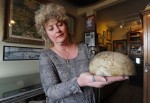Archaeologists excavating in Torre Satriano in the southern Italian region of Basilicata (the arch of the boot) have found a 6th century B.C. Greek building that comes complete with detailed assembly instructions. The building is a highly decorated, luxury structure with a sloping roof that is inscribed with descriptions of how the pieces of it slot together.
The roof was designed to filter rainwater down decorative panels, known as cymatiums, with projections designed to protect the wall below from dripping water.
“All the cymatiums and several sections of frieze also have inscriptions relating to the roof assembly system,” explained the Director of Basilicata University’s Archaeology Schoool Massimo Osanna.
“So far, around a hundred inscribed fragments have been recovered, with masculine ordinal numbers on the cymatiums and feminine ones on the friezes”.
The end result is a kind of instruction booklet, with every component identified by its own symbol and, as in modern systems, categorized as masculine or feminine depending on how it fits together with other parts.
So insert tab A into slot B and get yourself a Greek temple kind of thing.
The decorative elements are very similar to those found on a structure in a nearby town. They may have in fact been cast from the same molds. The team thinks that these structures were the result of a local builder taking advantage of the fashion for all things Greek at the time to create expensive build-it-yourself kits.
Greeks had invaded the region a century before then, but they were mainly in the south of Basilicata along the coast. Potenza, which is at a high elevation in the northern part of the region, was still very much on the outskirts of Greater Greece. Local knock-offs would have been both more available and more affordable.





